|
|
- Previous version - All Financial Sector Fact Sheets -
Canada’s Financial Services Sector
Canada's Life and Health Insurers
Updated Version (August 2001)
Overview
- Canada’s life and health insurance industry comprises some 117 firms, down from 168 companies operating in the sector in 1990. Canadian life and health insurers include companies incorporated both domestically and abroad.
- With the increased consolidation in the industry, the five largest companies represent over 54 per cent of the domestic market in terms of premiums, and 57 per cent of domestic general assets, up from 48 per cent in 1994.
- The life and health insurance industry employs over 110,000 Canadians. Approximately half are employed full time by the insurers while the remainder work as independent agents.
- Canada’s life and health insurance companies have total domestic assets of $258 billion, which ranks third among the country’s financial industries, behind banks ($1,023 billion) and the mutual fund sector ($390 billion).
- Total revenue for the sector in 1999 was roughly $75 billion. Approximately two-thirds of this amount was from premium income and one-third from earnings on investments.
- In the Canadian market, the market share of Canadian-controlled companies has increased over the past decade from 69 per cent to 72 per cent of total premium income collected.
- International operations have become increasingly important to Canadian insurers. Foreign premium income now accounts for half of the sector’s total premium income.
- Retirement products such as annuities, registered retirement savings plans and registered retirement income funds represent one of the fastest-growing areas of the life and health insurance business.
- Regulation of Canada’s life and health insurance industry is shared between the federal and provincial governments. With respect to prudential regulation, the federal government, through the Office of the Superintendent of Financial Institutions, supervises the federally incorporated firms (including foreign firms), which account for over 90 per cent of the total sector’s premium income. While there is some market conduct regulation at the federal level, all insurers are subject to market conduct regulation by the province in which they carry on business.
- Legislation was passed in 1999 allowing the life and health insurance companies to convert from mutual companies (owned by policyholders) to stock companies (owned by shareholders). Canada’s five largest life and health insurance companies are now publicly held.
Introduction
The life and health insurance sector plays an important role in the lives of Canadians by providing insurance against unexpected events and helping individuals plan their financial future. Traditional insurance, such as life and disability insurance, spreads risk across many persons to insure against loss of life, serious disability affecting employment, or need for additional medical attention.
In 1999, 82 per cent of Canadian households were covered by some form of life insurance, and domestic firms accounted for 72 per cent of that business. Further, the total value of life insurance owned by Canadians was nearly $2 trillion, almost double the amount owned only 10 years earlier. While the sector has traditionally been focused on life and health insurance products, there is now an increasing focus on wealth management and retirement products (see box on next page).
Structure of the Industry
As of August 2001, Canada’s life and health insurance industry comprises 117 firms – 107 stock companies (company shares are publicly traded) and 10 mutual companies (shares are held by policyholders) – down from 168 companies in 1990 (see Table 1). Much of the consolidation activity has involved foreign insurers selling their operations to Canadian insurance companies.
The top five companies, which are all stock companies, represent approximately 57 per cent of the Canadian life and health insurance market, based on the share of domestic general assets, up from 48 per cent in 1994. In addition, the top five insurers are all Canadian-controlled firms that continue to gain market share over foreign insurers.
Table 1
|
|
|||
|
Category |
Number of active firms (1999) |
Percentage of premium income | |
|---|---|---|---|
|
|
|||
| By incorporation | Canada | 75 | 91% |
| U.S. | 41 | 4% | |
| Europe | 11 | 5% | |
| Total | 127 | 100% | |
| By registration | Federal | 100 | 94% |
| Provincial | 27 | 6% | |
| Total | 127 | 100% | |
| By ownership* | Stock company | 114 | 95% |
| Mutual company | 13 | 5% | |
| Total | 127 | 100% | |
|
|
|||
* Post-1999, following demutualization (see page 6 for a definition of this term).
Source: Canadian Life and Health Insurance Association Inc.
Approximately 110,000 Canadians are employed in the life and health insurance sector, making it a significant contributor to Canada’s economy. About 57,000 are employed full time by the insurers while the remainder work as independent agents. In total, the life and health insurance industry employs more people than the forestry, chemicals, or pulp and paper sectors.
Distribution Network
Individual life insurance products are distributed by full-time career agents, who tend to represent a single company, or by independent agents who sell the products of any insurer. Both career and independent agents are paid sales commissions to cover their expenses, although career agents usually receive additional payments such as pension benefits and access to employer-paid training. While the majority of individual insurance products are sold through career or independent agents, other distribution channels include telephone and mail solicitation as well as sales over the Internet.
Life and Health Insurers’ ProductsCanada’s life and health insurance companies figure prominently in the market for life insurance, private sector health insurance (which complements public insurance plans) and annuities, which include private pensions. Life insurance now makes up a smaller proportion of products sold, while savings products such as annuities have assumed a greater prominence. For example, in 1970 annuities, including group and individual retirement products, accounted for only 19 per cent of premium income; by 1999 they represented 51 per cent. The aging of Canada’s population and increased demand for retirement income are seen as the main reasons for the increase. Life insurance (27 per cent of total premium income)Sales of life insurance have grown rapidly in recent years, with individual insurance showing faster growth than group insurance. Individual life insurance can be classified as two basic types: term insurance and permanent insurance. Term insurance offers benefits on death only and does not build up cash values. The premiums are lower in the initial years and increase over time to reflect higher mortality rates at older ages. Policies usually terminate at a specific age – e.g., 65, 70 or 75. Alternatively, permanent insurance offers more than death protection. These policies build cash value to help meet financial emergencies, pay for specific goals or provide retirement income. The policyholder who redeems the policy is entitled to its cash value. About 17 million Canadians own some form of life insurance. Accident and sickness insurance (22 per cent of total premium income)While Canada has a publicly funded system of medical and physician services, life and health insurers play an important role throughout the country in funding health services not covered under government programs. These services include extended health care benefits, dental insurance, travel insurance, disability income insurance and accidental death and dismemberment benefits. Canada’s life and health insurance companies provide over 90 per cent of Canada’s private health insurance, with the remainder provided by some property and casualty companies. In 1999, fully 22 million Canadians had extended health care insurance, 15 million Canadians had dental insurance and nearly 8 million were covered by disability income insurance. Much of this insurance is provided through benefit plans provided by employers for their workers. Annuities (51 per cent of total premium income)Annuities include group retirement plans and individual retirement products administered by insurers. Group retirement plans include private pension plans sponsored by employers and known in Canada as registered pension plans. They play an important role in Canada, with about 41 per cent of eligible Canadian workers belonging to such plans. Individual retirement products include annuities that are in the process of being paid out, such as life annuities and registered retirement income funds, as well as annuities still in the accumulation phase such as registered retirement savings plans. Total premiums received from annuities rose by 14.9 per cent in 1999 over the previous year as demand for segregated – or market-based – investment products remained strong (see the "Assets and Liabilities" section for a description of segregated funds). |
Group life and health insurance is usually distributed through employer-sponsored benefit plans and sold through a competitive bidding process, which helps minimize the cost of product distribution.
International Operations
Life insurance services are sometimes characterized as Canada’s most important financial services export. Over a dozen Canadian-controlled life and health insurance companies operate branches and subsidiaries in more than 20 countries. Foreign premium income for the sector has been growing steadily in recent years, increasing from 37 per cent in 1990 to 50 per cent in 1999 (see Chart 1). Although the United States provides the bulk of foreign premium income, life and health insurance companies are active in other markets, particularly the United Kingdom and Asia.
Canadian-controlled companies collect more premium income abroad than foreign-owned companies collect in Canada. Indeed, the share of total premium income collected in Canada by Canadian-controlled companies has increased over the past decade from 69 per cent to 72 per cent. This trend is expected to remain in place as the domestic industry continues to consolidate.
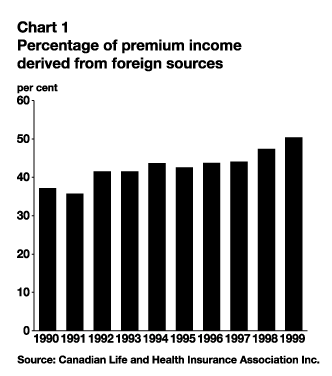
Income
Life and health insurance companies receive revenue from premium income (i.e., premiums paid by policyholders) as well as from earnings on investments. Premium income accounts for about two-thirds of industry revenues, with earnings on investments accounting for the rest. Total premium income in 1999 was $39.4 billion, of which 51 per cent was from annuities, 27 per cent from life insurance policies and 22 per cent from health insurance (see Chart 2). Total premium income grew by 9.7 per cent in 1999, above the annual average rate of 6.4 per cent over the 1990s.
Assets and Liabilities
At the end of 1999, Canada’s life and health insurance companies reported domestic assets of $258 billion, ranking them third in the Canadian financial sector after banks ($1,023 billion) and the mutual fund sector ($390 billion).

Chart 3 shows the asset structure of the Canadian life and health insurance sector. At the end of 1999, total domestic assets were allocated as follows: 40 per cent bonds, 17 per cent stocks, 16 per cent mortgage loans, 12 per cent mutual funds, 3 per cent real estate, and 12 per cent in cash, policy loans and other assets. Over the past decade, the percentage of assets in mortgages has declined steadily owing to the sharp decline in commercial real estate values in the early 1990s, while the percentage in stocks and mutual funds has increased in tandem with the strength in equity markets.
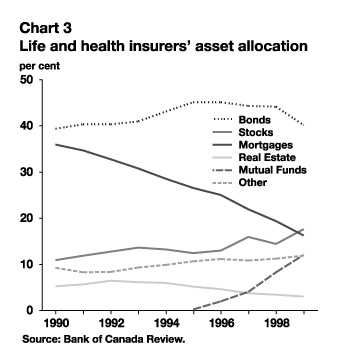
Assets can also be broken down into general assets and segregated fund assets. The assets held in a segregated fund are held and managed separately from the other assets of the firm and are used for investing funds from individual and group retirement plans and annuities. General assets include all other assets of life and health insurance companies.
Segregated fund assets rose by 27 per cent in 1999 over the previous year, as consumer demand for equity-based retirement products remained strong.
What Are Segregated Funds?Segregated funds, available only from life and health insurance companies, are similar to mutual fund products offered by other financial institutions in that they offer shares of investment funds in a variety of securities (e.g., equity, bonds, balanced funds). However, they differ from mutual fund products in that a minimum percentage of the investment – usually 75 per cent or more – must be returned to the investor when the fund matures. The term "segregated" is used because the funds must be kept separate, or segregated, from the other assets of the insurance company. Segregated funds are used for the investment of contributions to group pension plans as well as the investment of funds from individual annuities. Segregated fund assets are making up an increasingly greater proportion of the sector’s total assets, with almost $76 million of assets – representing 30 per cent of the domestic life and health insurers’ total assets – held in segregated funds in 1999. This represents a 27-per-cent increase over the 1998 figure of $59.5 million and more than four times the 1989 level. Although segregated funds have tended to be invested largely in common stocks and bonds, mutual funds are now the largest investment vehicle. |
In 1999, 40 per cent of the life and health insurance sector’s segregated assets were held in mutual funds, 30 per cent in stocks and 16 per cent in bonds.
At the end of 1999, domestic actuarial liabilities (i.e., funds needed to honour future benefits and expenses plus an allowance for adverse experience) equalled $198 billion, or 72 per cent of total domestic assets of Canadian life and health insurers. Chart 4 shows the sector’s liability distribution. The majority of the liabilities are for annuities, which made up 71 per cent of total liabilities in 1999. Life insurance accounted for 22.4 per cent of total liabilities and health insurance for the remaining 6.6 per cent. The liability distribution has been relatively stable over the past decade.
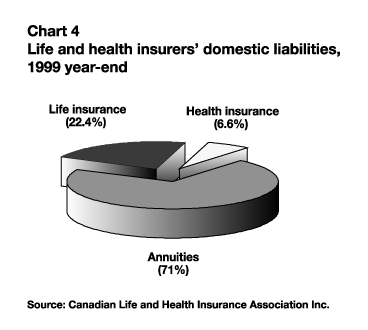
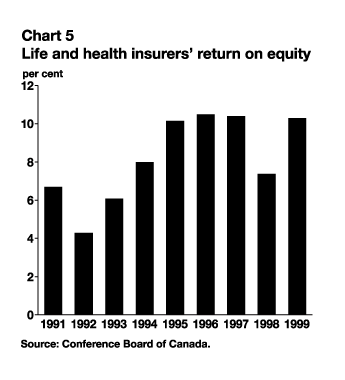
Return on Equity
The life and health insurance sector reported a return on equity (ROE) of over 10 per cent for four of the past five years, well above the ROEs posted at the beginning of the 1990s (see Chart 5). The increase in profitability is primarily attributable to the increasing popularity of insurers’ products, particularly wealth management and retirement products. The lower ROE reported in 1998 reflects the United Kingdom pension writedowns and Asian asset writedowns by some of the larger Canadian life and health insurance companies.
A New Legislative Framework – Demutualization and a New Ownership Structure
In March 1999, the Parliament of Canada passed legislation allowing mutually owned life and health insurance companies, which are owned by insurance policyholders, to convert into stock companies, which are owned by shareholders. This process is known as demutualization. Policyholders were given the option of becoming shareholders or receiving a cash payment in lieu of shares.
The legislation also required that the insurance companies remain widely held (i.e., no individual can hold more than 10 per cent of the shares of a company) for two years following their demutualization and that no mergers among, or acquisitions of, demutualized firms be allowed during this two-year period. These restrictions were intended to give management of the newly demutualized companies time to adjust to operating as a stock company and to bring their financial performance in line with other publicly held companies.
In June 2001, the Government of Canada passed legislation reforming the regulatory framework governing the financial services industry. This legislation includes measures affecting the life and health insurance sector. The legislation states that the transition period, during which no mergers or acquisition of demutualized firms are permitted, will end on December 31, 2001, in order to give a common end date to all firms. Additionally, during the transition period, investors will be able to acquire up to 20 per cent of voting and 30 per cent of non-voting shares of demutualized insurers that had a surplus of greater than $5 billion according to their last annual statement before demutualization. This measure will provide these insurers with increased flexibility to enter into strategic alliances and joint ventures, and bring the sector in line with the banking sector.
Further, during the transition period, no person is able to acquire more than 10 per cent of any class of shares of any demutualized insurer that had a surplus of less than $5 billion according to its last statement before demutualization. This restriction is intended to prevent any undue advantage being provided after the transition period to a larger firm or individual considering a major purchase of these mid-sized insurers during the transition period.
After December 31, 2001, demutualized insurers with equity of under $5 billion will automatically be eligible to be closely held under the legislation. Those demutualized companies with over $5 billion in equity will, as a matter of government policy, continue to be widely held (i.e., an individual or firm will be limited to 20 per cent of voting shares). Large banks will not be permitted to acquire or merge with large demutualized insurance companies and vice versa. This restriction will also apply to large bank or life and health insurance holding companies. The threshold above which all financial institutions, including life and health insurance firms, must have a 35-per-cent public float will be raised from $750 million to $1 billion.
The legislation also includes provisions that allow life and health insurance companies access to the Canadian Payments System, which is the clearing and settlement system for processing cheques and other types of payment items between financial institutions. This change will allow life and health insurance companies to offer a broader range of services, including payment services to customers similar to those found in deposit accounts offered by banks.
Financial service providers, including demutualized insurance companies, will also have the option of restructuring under a holding company structure. This will provide them with the potential for greater operational efficiency and lighter regulation.
There are also measures in the legislation to empower and protect consumers of financial services. The Financial Consumer Agency of Canada will enforce the consumer-oriented provisions of the federal financial institution statutes, monitor the industry’s self-regulatory initiatives designed to protect the interests of consumers and small business, promote consumer awareness and respond to general consumer inquiries. A new Canadian Financial Services Ombudsman (CFSO) will also be established to handle the complaints of consumers and small business regarding their dealings with financial institutions. While they are not required to join the CFSO, the life and health insurers are required to be members of a third-party dispute-resolution system and are welcome to choose the CFSO.
In addition, life and health insurers have operated the Consumer Assistance Centre for the past 30 years through the industry’s national trade association. The Centre provides information and services, including complaint management and policy search assistance.
Regulation and Supervision
The federal and provincial governments share jurisdiction over life and health insurance companies. In practice, the sector is largely regulated for financial soundness by the federal government as federally incorporated companies make up over 90 per cent of the total premium income for life and health insurers. While provinces reserve the power to ensure that federally incorporated companies conducting business in their respective jurisdictions are financially sound, all provinces, with the exception of Quebec, accept federal regulation in this regard. In addition, the majority of provinces have agreements with the federal regulator to carry out prudential supervision of provincially incorporated companies on their behalf.
Federal oversight is administered by the Office of the Superintendent of Financial Institutions (OSFI), which is responsible for supervising financial institutions, including life and health insurers, to ensure that they are in sound financial condition and in compliance with the law that governs federally regulated financial institutions. If they are found lacking in this regard, OSFI can advise management and require remedial action to be taken. In undertaking this work, OSFI measures life and health insurance companies’ capital adequacy by applying the Minimum Continuing Capital and Surplus Requirements (MCCSR) guideline.
The MCCSR measures the minimum capital and surplus required by a company, adjusted for risk factors of the business and its investments, to ensure assets are sufficient to cover their liabilities. It has two main components. First, a risk-based formula is applied to determine how much capital is required by the firm. Then the amount of capital or "margin" which is needed to meet this risk-based requirement is assessed. If the capital of the firm falls below 120 per cent of the minimum required, the company must provide OSFI with detailed plans for raising capital. Companies are also required to submit annual reports to OSFI, detailing financial data, including their assets, liabilities, receipts and disbursements. As shown in Chart 6, the life and health insurance sector is generally well capitalized at 11.2 per cent in 1999, up from 10.7 per cent in 1998.
All insurers are subject to market conduct regulation by the province in which they carry on business. This includes the licensing and marketing of insurance company products, standards of competence and behaviour of insurance agents, and consumer protection. The provincial acts governing insurance contracts and beneficiary rights are modelled on the Uniform Life Insurance Act, which is a model law adopted by the Canadian Council of Insurance Regulators to regulate life insurance policies. While Quebec has not adopted the Uniform Act, its regulations in this area are very similar. All provinces, including Quebec, continue to pursue further harmonization.
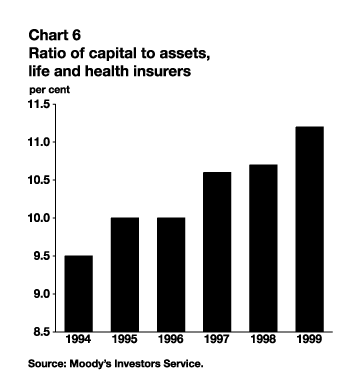
The federal government is also active in the area of market conduct, but to a lesser degree. For example, under the new legislative framework passed in 2001, federally incorporated life and health insurance companies are required to be members of a third-party dispute-resolution system to handle the complaints of consumers and small business.
Policyholder Protection
Since 1990, life insurance policies, accident and sickness policies and annuity contracts in Canada have been guaranteed up to certain limits by the Canadian Life and Health Insurance Compensation Corporation (CompCorp), a private, non-profit corporation created and financed by the life and health insurance companies. This plan provides policyholder protection in the event of loss of policy benefits due to the insolvency of their life and/or health insurance company. Coverage is $200,000 for death benefits under life insurance policies, $60,000 for cash accumulation plans and health benefits, and $2,000 per month for disability and regular annuity income benefits. With few exceptions, CompCorp’s membership includes all insurance companies licensed in Canada to sell life and health insurance to the public. (For further information, see CompCorp’s Web site at: www.compcorp.ca.)
Future Challenges
Like other players within the financial services industry, the life and health insurance sector is undergoing rapid change. Technology is having an impact on all aspects of the sector, from distribution – policies can be bought at any time from any place over the Internet – to online trading of company shares. Growth in information technologies is also globalizing financial markets and has led to a significant increase in cross-border financial transactions. Consumers have greater access to insurance products, whether they be domestic or foreign, and can access those policies which best meet their needs. Competition is also increasing from other financial institutions including banks and mutual fund dealers, who offer a wide range of investment products.
The sector also faces challenges from the changing demographics of the North American population. The strong popularity of annuities is partly due to the desire by the baby boom generation for retirement income. As this segment of the population ages, it could affect the distribution share of life and health insurance products, with annuities making up a larger portion of the market. The proportion of annuities being paid out will also likely increase. In addition, the aging of the population will likely affect claims paid out for the more traditional life insurance products.
In the face of these pressures, the life and health insurance sector continues to consolidate. Industry analysts expect this trend to continue, as demutualization provides the share capital needed for acquisitions. Some smaller life and health insurance firms may meet these challenges by focusing on niche markets.
The legislation to reform the regulatory framework governing the financial services industry is intended to support the life and health insurance sector in meeting these challenges by providing a flexible environment in which to operate, while maintaining strong prudential regulations. The new framework maintains the long-standing practice of ensuring regular updating of the regulatory framework by including an automatic five-year review in the legislation. The Government is also prepared to revisit the legislation prior to the five-year review, if necessary, to ensure the framework keeps pace with the rapidly changing marketplace.
Further information on legislation to reform the financial services sector can be obtained from the Department of Finance at http://www.fin.gc.ca/. Additional information on the Canadian life and health insurance sector is available from the Office of the Superintendent of Financial Institutions at
http://osfi-bsif.gc.ca/ and from the Canadian Life and Health Insurance Association Inc. at http://www.clhia.ca/.
Annex
Concentration in the Canadian Life and Health Insurance Sector: Domestic General Assets, 1999
|
|
||
|
Domestic |
Market Share (%) |
|
|---|---|---|
|
|
||
| The Great-West Life Assurance Company | 27.7 | 15.2 |
| Clarica Life Insurance Company | 25.2 | 13.8 |
| Manulife Financial Corporation | 20.8 | 11.4 |
| Sun Life Financial Services of Canada Inc. | 17.4 | 9.5 |
| Canada Life Financial Corporation | 13.7 | 7.2 |
| Total (top 5) | 104.8 | 57.4 |
| Industry Total | 182.6 | 100.0 |
|
|
||
Note: Numbers may not add up due to rounding.
Sources: OSFI, Canadian Life and Health Insurance Association Inc.
Top 10 Firms by Total Assets (General and Segregated),
Consolidated Basis, 1999
|
|
|
|
Company |
Total Assets |
|---|---|
|
|
|
| Manulife Financial Corporation | 105,940 |
| Sun Life Financial Services of Canada Inc. | 101,831 |
| The Great-West Life Assurance Company | 86,941 |
| Canada Life Financial Corporation | 52,591 |
| Clarica Life Insurance Company | 36,776 |
| The Maritime Life Assurance Company | 10,561 |
| The Imperial Life Assurance Company of Canada | 4,906 |
| The Empire Life Insurance Company | 3,989 |
| The National Life Assurance Company of Canada | 3,716 |
| Industrial-Alliance Pacific Life Insurance Company | 2,106 |
|
|
|
Note: Includes assets from operations in Canada and in other countries.
Source: Moody’s Investors Service.
| Last Updated: 2004-11-03 | |||||